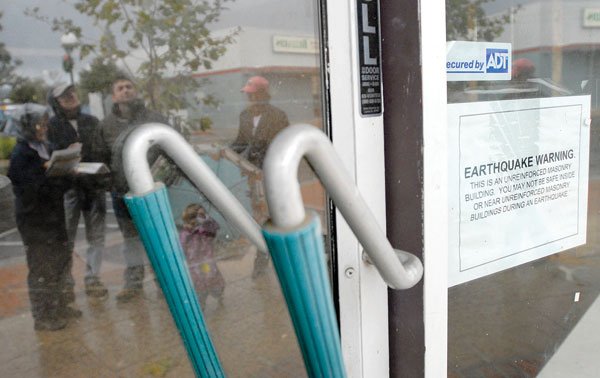
In 1986, the Space Shuttle Challenger disintegrated high above the Atlantic Ocean shortly after takeoff; the Chernobyl Nuclear Power Plant in the Ukraine had a meltdown depositing radioactive particles in nearly every northern hemisphere country; and the final credits rolled on legendary actor James Cagney’s life.
It was also the year legislators enacted the California URM Law requiring cities located in the so-called “seismic zone 4” – which runs the length of the California Coast – to inventory their unreinforced masonry buildings deemed structurally unfit to survive high magnitude temblors. Under the law, cities must report the findings to the state and work on getting the buildings up to code, or reducing the number of occupants in them.
Twenty-seven years later, after numerous outreach meetings designed to foster collaboration between the City and URM building owners; establishing a URM Task Force; drafting voluntary and mandatory retrofit requirements and the threat of numerous fines for URM building owners; the issue of how – and with what money – downtown Gilroy’s 18 URMs will be brought up to code and occupied by businesses was once again bandied around the City Council dais during its June 17 regular meeting.
“Getting these buildings occupied is of critical importance to the city,” surmised Development Center Manager Lee Butler as he presented staff’s eight financing ideas aimed at kick-starting the mandatory or voluntary seismic retrofitting of Gilroy’s URM structures.
Cajoling the building owners into moving ahead with the retrofit work – which includes securing URM walls to the roof and floors in multi-story buildings, bracing parapets and repairing or removing façades – has been less than successful.
Out of the 18 buildings, five have been issued building permits since 2011, but only two of those have started any work at all. The remaining 16 have made no construction progress, according to documents furnished by the City.
The argument over who should pay for what when it comes to URMs and Gilroy’s retrofit requirements is at the core of the fiscal conundrum stalling progress on tackling what many view as downtown’s biggest blight.
During the June 17 City Council meeting, members whittled seven financing options down to two. Council directed staff to examine those options further and to report back in the fall. The two options – a Voluntary Seismic Safety Assessment District and a Community Facilities District – would be funded by a City bond issue.
The bond issue for either of these options – which would be paid back to investors by only the URM building owners via an assessment added to their property tax bill over 20 to 30 years – would cover the total cost of the retrofits. The assessment added to each individual URM building owner’s property tax bill would depend on how much money had been spent to bring the building up to code.
“There will be wide variation in the numbers,” Butler reasoned. “Some buildings were made on the cheap.”
If enough owners are interested, the City would likely opt for the Voluntary Seismic Safety Assessment District. The Communities Facility District requires a two-thirds majority of URM building owners to agree to the deal in order to make it mandatory for all.
Councilmembers Dion Bracco and Cat Tucker wanted to know why Gilroy couldn’t just write a new local ordinance that would help get tenants in the buildings. After all, Gilroy’s Seismic Safety Ordinance – not state law – is preventing URM occupation by setting the bar high with stringent retrofitting rules surpassing other seismic zone 4 cities such as Morgan Hill.
“So all we have to do then is change our local ordinance and then we don’t have to deal with any of these options?” Tucker asked. “Is that an option that staff has looked at?”
Butler explained the URM Task Force could consider it an option, but it’s an unlikely option because of safety concerns.
City Attorney Linda Callon also weighed in.
“If there is injury, the City is going to end up being sued,” she cautioned, pointing to the protection afforded by Gilroy’s present seismic safety ordinance.
A partially mollified Bracco questioned whether any building owners would ever get on board with the retrofits, regardless of how many different forms of financing the City dangles in front of them.
“They’re not going to put $1 million into a $200,000 piece of property,” he reasoned.
Mayor Don Gage seized the moment to put forth his own suggestions for some of the URMs.
“Maybe the answer is to pay for them to be taken down,” Gage posited.
Gage’s “Quality of Life” bond measure vote tentatively scheduled for November 2014, if passed, could possibly fund that undertaking. The bond measure could potentially create a revenue stream ranging from $25 to $35 million – providing cash injections that could augment multiple projects citywide. Finally dealing with downtown Gilroy’s URM buildings was on Gage’s to-do list when he floated the idea to Council in late May.
Not everybody in the audience, however, was thrilled with Gage’s suggestion of razing the URMs.
“Tearing down these buildings would destroy the character of downtown and lower property values,” said community member John Russell, during public comment time. “We have nobody waiting to build there and we’d be losing a significant part of our history.”
Offering up more carrots instead of sticks to the building owners, Russell explained, should be the approach Council takes on the issue.
“I’d like to see a constructive solution,” Russell observed. “One that preserves that character of Gilroy and doesn’t turn us into just yet another suburb of San Jose.”
Local developer Gary Walton followed Russell to the speaker’s lectern and tried to quantify the damage being done to Gilroy’s bottom line by the URM ordinance and the potential losses involved in maintaining the status quo. He agreed with Russell that more options need to be put on the table to get downtown’s economic heart beating stronger.
“Ten million dollars. That’s the economic loss in one year by having 25 small retail buildings in the downtown empty,” said Walton as he presented his calculations. “That’s $27,397 a day that we’re losing in economic activity.”
Russell and Walton’s pleas for more time and dialogue cut no ice with fellow audience member Tom Fischer, however.
Pointing to myriad olive branches proffered by successive Councils to the business community to resolve the URM problem – including free engineering analysis and stiff fines that were rescinded before they were to be collected – Fischer painted a picture of some business owners who have ignored and rebuffed everything placed in front of them.
Seven of the 18 listed building owners have mailing addresses outside of Gilroy; the list of addresses stretch from Hesperia – near San Bernardino in the Mojave Desert – to San Francisco.
“It is unconscionable that after more than 20 years we are still talking about this,” Fischer said. “Most cities of our size put this issue to bed years ago. It’s time to put public safety first.”
Councilwoman Terri Aulman reminded the rest of the dais of the expectation that Gilroyans have in the Council to manifest the promised vision of a vibrant downtown.
“It’s not a ‘Can you? Will you?’” Aulman challenged. “We’ve been trying for 30 years, it’s time to get tough.”













